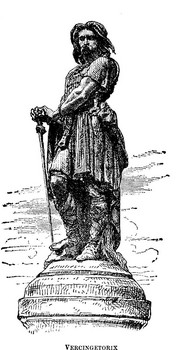Julius Caesar and Gaul
Part 1: Clash of the Titans In his conquest of Gaul, Julius Caesar subjugated a huge number of varying tribes that nonetheless shared a common culture, their own coins, an established art movement, walled towns, established and famous urban centers, a settled agriculture, and a stable religious system. In 62 B.C., the Arverni had attack another Gallic tribe, the Aedui, which at the time had an alliance with Rome. The Romans were content to let Gauls fight amongst themselves at that point; but when the Helvetii, a large Germanic tribe, marched across Gaul, Caesar himself got involved. After a number of attempts at battle and keeping the peace, the two armies clashed in the Battle of Bibracte and the Romans were victorious. The Romans again intervened in Gallic fighting in 57, marching against the Belgae. That tribe, allied with the Nervii, gave the Romans great pause, but Caesar again was successful and became more involved in controlling Gaul. While Caesar and several legions were invading Britain (once each in 55 B.C. and 54 B.C.), Gallic tribes on the mainland were busy harrying Roman emplacements. Ambiorix, leader of the Eburones, led an uprising that was successful for a time. Caesar himself took charge of the Roman forces and, in 53 B.C., put down the Eburone revolt.  After initially convincing the normally warring tribes that they needed to band together or else fall separately, Vercingetorix turned his attention to the invading Romans. Seeing that the Roman troops had the advantage in discipline, he resorted to a "scorched earth" policy for the people he commanded, not all of whom heeded that order. As a result, the invading Romans were free to continue their advance and successes. After initially convincing the normally warring tribes that they needed to band together or else fall separately, Vercingetorix turned his attention to the invading Romans. Seeing that the Roman troops had the advantage in discipline, he resorted to a "scorched earth" policy for the people he commanded, not all of whom heeded that order. As a result, the invading Romans were free to continue their advance and successes.Vercingetorix gathered his forces at Alesia, a massive citadel and capital of the Mandubrii tribe. Intending to surprise the Romans with a quick cavalry charge, Vercingetorix instead found himself on the losing end of a battle, thanks to Caesar's co-opting of some recently made-available German cavalry. Confident that he knew his enemy, Vercingetorix opted to stay at the hilltop fortress of Alesia and wait for Caesar to come to him. Next page > Victory for Rome > Page 1, 2 |
|
Social Studies for Kids
copyright 2002–2024
David White



 The main Celtic tribes that populated
The main Celtic tribes that populated 
